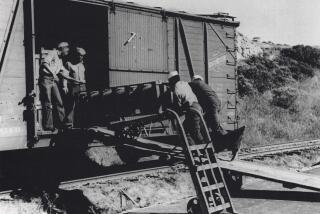Sailor Convicted in Dumping of Medical Waste : Court-martial: Corpsman sentenced to brig because hazardous waste was dumped behind a San Diego store by the sailor’s wife after she found it in his car.
- Share via
A San Diego sailor was court-martialed after officials learned that his wife dumped a large cache of Navy medical waste--including AIDS blood-test samples--behind a Normal Heights video store last summer.
In what officials believe is one of the Navy’s first dumping cases in which a culprit was found and punished, the sailor was demoted, fined $482, and ordered to spend 15 days in the brig after being found guilty of illegally transporting medical waste.
“This will tell everyone on the ships and on bases that we are extremely serious about not dumping hazardous waste,” said Cmdr. Doug Schamp, a Navy spokesman. “In the past, someone felt fairly anonymous if they just threw stuff overboard, but those days are gone.”
Navy hospital corpsman Wade Bliss, 24, had stuffed eight bags of medical waste into the trunk of his car when he found himself locked out of a waste disposal shed, The Times reported in September. When his wife used the car, she found the bags and tossed them into the trash bin of the video store where she worked.
The eight bags contained several hundred used syringes, bloody bandages, bacteria cultures and blood samples used for AIDS and venereal disease tests. The bags, marked “CAUTION: BIO-HAZARDOUS WASTE MATERIAL,” were found in a trash bin behind Blockbuster Video in the 3500 block of El Cajon Boulevard in July.
Bliss was found guilty of dereliction of duty and illegally transporting hazardous material in a summary court-martial Oct. 30, said Lt. Susan Haeg, a Navy spokesman. He was ordered to serve 15 days in the brig at 32nd Street Naval Station and he was demoted from seaman to seaman recruit. That demotion reduced Bliss’ pay by $200, so he will now earn $724.20 monthly, Haeg said.
Bliss was also fined $482.32 and will be restricted to his ship, the submarine tender Dixon, for 30 days once he leaves the brig. Bliss, who entered the brig Oct. 30, was unavailable to comment. The Dixon would have handled the medical waste not only for itself but also for several submarines that its crew was repairing.
“It is good for other people who handle hazardous waste material to see there is pretty strong punishment associated with handling it,” said Linda Miller, spokeswoman for the San Diego County district attorney’s office and a member of the county’s Hazardous Waste Task Force.
The district attorney’s office, working with the Naval Investigative Service, traced the eight bags of waste to Bliss, whose wife, Maria, 21, worked at the video store. When those two agencies concluded their investigation, the reports were turned over to the Navy.
Store manager Steve King had discovered the bags and was alarmed when he saw the warning labels. King believed the bags might have contained radioactive material and called the health department.
“It was really nasty stuff,” he told The Times earlier this fall.
County health officials were alarmed by the find because of the amount and the infectiousness of the material. They were concerned that someone looking for recyclable trash might have inadvertently infected himself by coming into contact with the contaminated materials. They were also worried that drug addicts might have come across the cache and filched the needles--potentially exposing themselves to disease.
“It could have been very dangerous for the public,” Miller said.
The incident capped what has been a rough year for the Navy, with several waves of medical waste washing ashore that seemed to be connected to the military. But, in these cases, officials were unable to prove the waste was dumped from Navy ships or bases.
In May, three atropine injectors linked to a military depot were found on a San Diego beach. Later, syringes, prescription drug vials and intravenous tubing, as well as C rations, dotted shores from Carlsbad to Coronado.
This incident, however, has been the only one in which officials traced what happened. And it is also one of the largest quantities of medical waste to be dumped, said Gary Stephany, director of the county’s Environmental Health Services.
“We’ve gone the extra mile in this county to prevent this dumping from happening,” Stephany told The Times in an earlier interview. “I’d like to see the Navy do the same.”
More to Read
Sign up for Essential California
The most important California stories and recommendations in your inbox every morning.
You may occasionally receive promotional content from the Los Angeles Times.









